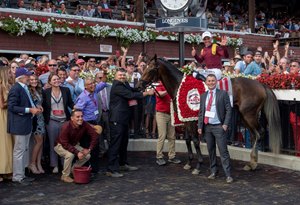Catholic Boy, Abel Tasman: From RNAs to Track Stars


It could have been me.
That's what some horse owners were likely telling themselves while watching the happy owners of Catholic Boy and Abel Tasman following their grade 1 victories Aug. 25 at Saratoga Race Course.
After all, both went unsold when offered at public auction, and their subsequent success at the highest levels of North American racing no doubt have left more than a few sale regulars with a serious case of "bidder's remorse."
Catholic Boy, impressive winner of the Runhappy Travers Stakes (G1), was bred in Kentucky by Fred W. Hertrich III and John D. Fielding and went unsold when he did not attain his reserve on a final bid of $170,000 as part of the Taylor Made Sales Agency offerings at the 2016 Keeneland Winter Mixed Sale in January. While it would have taken a tidy sum to have purchased the More Than Ready colt, it seems a bargain now that he has earned more than $1.8 million.
Abel Tasman, who posted her sixth career grade 1 triumph Saturday in the Personal Ensign Stakes (G1), did not attain her reserve and was bought back for $65,000 by her breeder Clearsky Farms, which consigned the Quality Road filly to the 2015 Keeneland September Yearling Sale. She has also proven a most fortuitous buy-back, with a bankroll of nearly $2.8 million.
Given the inexact science of selecting young horses with the potential to achieve greatness, it is inevitable some that slip through buyers' hands will later perform well.
The poster boy for buy-backs is American Pharoah , who was not an RNA, but was listed as having been sold for $300,000 as a yearling. In reality, he was bought back on behalf of his breeder, Zayat Stables, which was all too glad to race him to Triple Crown glory and then retire him in spectacular fashion to Ashford Stud.
Taylor Made's Mark Taylor doesn't recall specifically why buyers let Catholic Boy go through the sale ring unsold, but they quickly realized the missed opportunity and the consignor immediately began fielding post-sale interest. In the end, trainer Jonathan Thomas bought the colt for Robert LaPenta for nearly the final bid price.
The colt now races for LaPenta, Madaket Stables, Siena Farm, and Twin Creek Racing Stables.
"I don't recall the specifics, but I remember we were disappointed because we thought the horse was going to sell better than he did," Taylor said. "(Breeders) put their reserve where they thought it was pretty fair, but it just didn't get it done. Immediately after the fact, there was a lot of interest. He was just like one of those horses that went through and some of the people who were on him at the barn just missed him or didn't have themselves lined up to go that high.
"But it was readily apparent a lot of people were interested and that he was going to get sold."
Depending on the sale, official RNA rates range from about a low 20% for boutique yearling or 2-year-olds in training sales, to highs of 35-40% for sales with larger catalogs.
While every effort is made to sell the horses while they're in the sale ring, most consignors are prepared to finish the job back at the barn if need be. In most cases, the objective is to move the horse to a new home and the amount of money involved in post-sale private transactions can be at or near the final bid price.
"We work like hell to get them sold in the ring, but one thing we pride ourselves on is that we sell around 65 RNAs, post-sale, on an annual basis for a gross of between $4 million to $6 million," Taylor said. "You know you are going to have a certain number of RNAs, unless you are totally passive and put them in the sale with no reserve, but we have a really good system of post-sale sales. It's part of the game.
"There is always bidder's remorse, but it's amazing when you buy back a horse that becomes famous, there are like 20 underbidders who emerge," Taylor said of the sudden attempts to be associated with fame.
In the case of Abel Tasman, her failure to sell at auction could be attributed to unfavorable reports from some veterinarians reviewing endoscopic exams of the filly's throat.
"There was some confusion, with some people passing her and some did not," said Clearsky general manager Barry Robinette. "There was one group interested in her, but one vet representing several of them (potential buyers) put the rest of them off of her."
Of possible bidder's remorse, Robinette said, "I'm sure there is some head-scratching going on and they wish they could have that moment back. As it turns out, she was fine. Who knows how good could she could be if she had a good throat. But it worked out well for us."
After Clearsky put the filly in training under the care of Simon Callaghan, Abel Tasman won three of four starts, including the Starlet Stakes (G1) at Los Alamitos Race Course, as a 2-year-old. An interest in the filly was then sold to China Horse Club International and the filly was transferred to the barn of Bob Baffert.
While Hertrich and Fielding still have the mare Song of Bernadette, the dam of Catholic Boy, the same cannot be said of Clearsky and Vargas Girl. The dam of Abel Tasman, Vargas Girl was euthanized the night the Personal Ensign winner was born due to a ruptured uterus, Robinette said.
